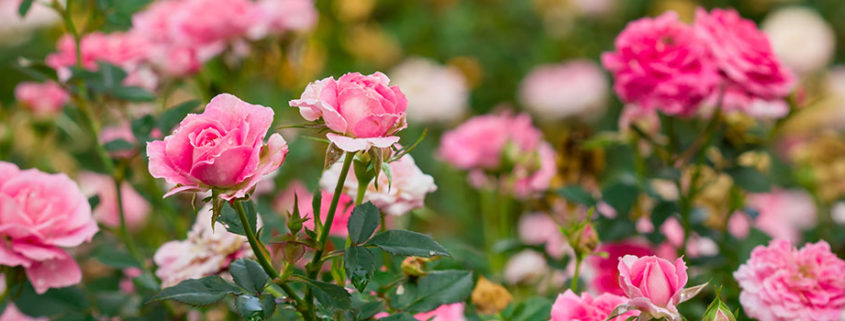Roses Can Be Versatile And Beautiful
Roses add a touch of elegance to the home garden or landscape. Roses are very versatile and there is a tremendous selection from which to choose. They can be used for almost all landscape purposes, with the exception of providing shade. In fact, a rose exists for practically every landscape design feature that requires the use of ornamental plants. And contrary to popular belief, roses do not necessarily require large amount of time or talent to be grown successfully.
Modern-day roses can be separated into five general categories.
Beginning with the most prevalent, the group includes hybrid tea roses, floribunda roses, climber and rambler roses, shrub roses, and miniature roses. While this method of grouping hardly tells the whole rose story, it does help the homeowner narrow the search to the class of group of roses that has the desired characteristics.
The Hybrid Tea is the most popular of all the roses. We think of the hybrid tea as the classic rose bloom – it is the one we purchase be the dozen from the florist. Knowing their popularity, it is somewhat surprising to learn that hybrid tea roses were not developed until the year 1867.
Rose breeding had been going on long before, but it was the introduction of Chinese roses the Western World that allowed breeders to make a giant leap in the development of new rose varieties. The first hybrid tea rose was cross between a Chinese tea rose and a hybrid perpetual.
If you are planning on taking cuttings for flower arrangements or if you are looking for a formal look, then the hybrid tea rose is certainty the way to go.
At my own home, I have 20 “Mister Lincoln” hybrid tea roses planted in perfect rows in a raised bed. With the rapid development of new hybrids, “Mister Lincoln” has now become a somewhat older variety. But I love the deep red color of the blooms and the long stems. Of course, hybrid teas can be planted in less formal arrangements and in a wide variety of colors.
On the down side, hybrid teas bloom less frequently and less prolifically than the next group we will discuss, the floribundas. As a precaution when choosing hybrid tea roses, whose claim to fame are their blooms, make your selection from live plants if possible, not photographs of the flowers. While the individual flowers may be magnificent, the blooms can sometimes be disappointing in number and short-lived. Also, it is important that you like the actual plant and that it fits well into the available planting space. For example, the variety I chose, “Mister Lincoln”, is too tall and open for a small planting bed.
The floribundas are the next group. They are a 20thcentury addition to the family of roses. They came into popularity in the 1950s, although they were developed decades earlier. The fact that a hybrid tea rose was one of the floribunda parents demonstrates the continuing evolution of commercial roses.
As the name floribunda implies, they produce abundance of beautiful flowers. They generally produce several more flowers per bush than hybrid teas and the blooms last considerably longer. Additionally, the floribundas are hardier and require less maintenance than the hybrid teas. The downside is that the floribundas lack the classic beauty and floral fragrance of hybrid teas. However, newer floribunda varieties are starting to overcome these drawbacks. No doubt we will continue to see breakthroughs in rose development.
While Hybrid teas and floribundas are relative newcomers, climbers and ramblers have been around for a long time. Climbers have been used for centuries to cover houses, walls, fences, and other vertical structures. Ramblers became popular in the Victorian era and were probably in common usage much earlier. Ramblers can be used as climbers but their stems are smaller and less rigid than the roses that are designated as climbers. Although in both cases the stems must be tied to the structure or otherwise supported.
Climbers are usually a better choice than ramblers. They are hardier and have larger and more prolific blooms. The thicker stems make them better adapted to vertical growth. Some hybrid tea varieties have been converted to climbers but the same precautions apply, consider the plant as well as the flower. There may be fewer blooms on hybrid tea climbers than you would like to see.
Shrub roses are sometimes referred to as “old-fashioned” roses. Although they have also been improved for garden through hybridization, much of their parent history is from ancient or wild rose species. As a general rule, expect this group to be extremely hardy and need little care. Certain varieties can even be used as ground-cover.
Miniature roses also disappeared from the scene in the early 1900s but since have had a popular resurgence. They can be grown in window boxes, serve as the border of flower beds or used in numerous other specialized applications.
Although more common now than in the past, there are still novel enough to draw attention and conversation.
Tree roses are also popular, but they are not a separate group. They can be trained from hybrid teas and floribundas in particular, as well as from some other groups.
Other subgroups and specific use roses can easily be researched and obtained by the interested gardener or homeowner.
The popularity of roses has led to an infinite amount of information that is readily available.
In preparation to writing this article, I discover I had six books in my home library dedicated entirely to roses, as well as chapters and sections on roses in other gardening books.
In the next blog we will talk about the proper planting and subsequent care of roses.



Follow Us!